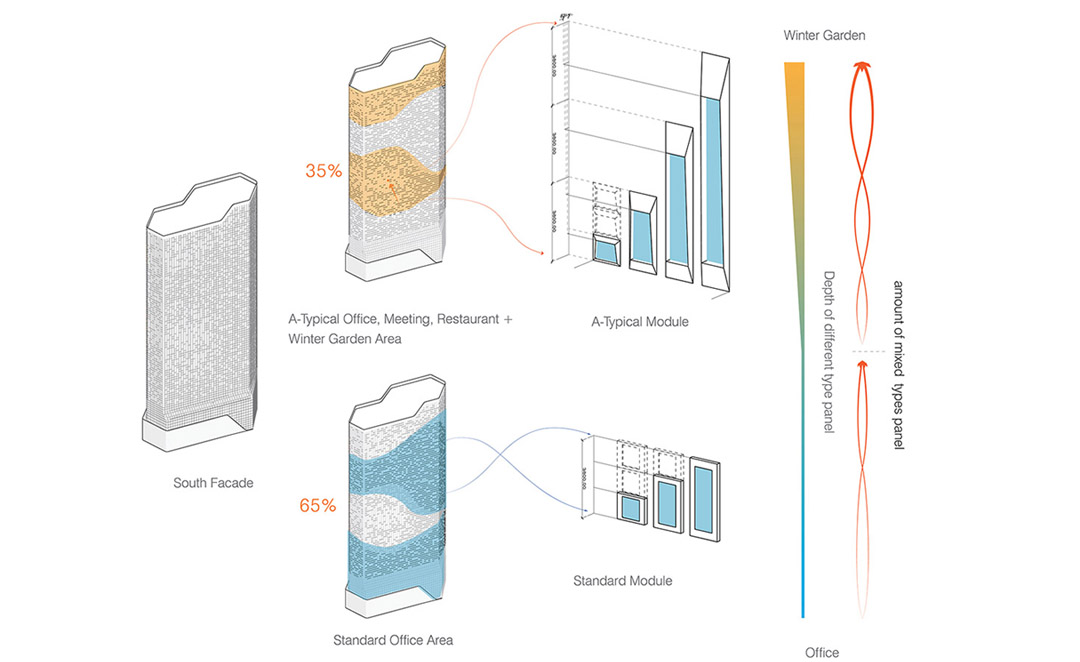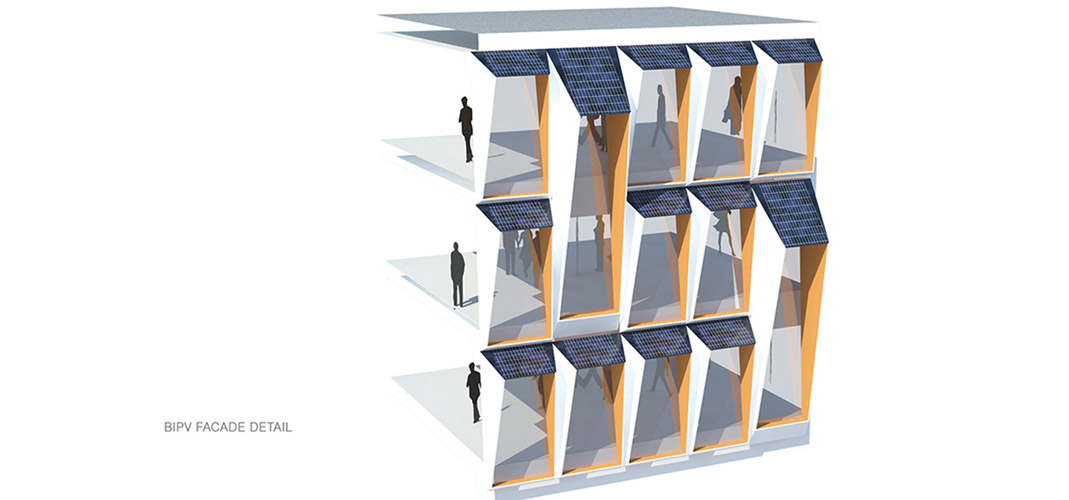UNStudio最近中标Hanwha首尔总部办公楼重建项目。随着对总体景观的重新设计,重建对办公大楼的外观、内部公共空间、大厅、会议层、礼堂和办公区都进行了重整。坐落于首尔清溪川,面积为57696平方米的Hanwha总部大楼曾一度被认为不能再反映其作为世界上领先环境技术提供商的地位象征。为此Hanwha公司拉开总部办公大楼重建比赛,UNStudio与Arup(建筑可持续性与幕墙顾问)以及Loos van Vliet(景观设计师)和agLicht(大楼内部、景观和外墙照明的照明顾问)联手,最终赢得比赛。
Ben van Berkel / UNStudio’s design selected as winning entry for the remodelling of the Hanwha Headquarter office tower in Seoul.
UNStudio’s design has been selected as the winning entry in the competition for the remodelling of the Hanwha headquarters building in Seoul. The renovation of the office tower incorporates the remodelling of the facade,the interior of the common spaces, lobbies, meeting levels, auditorium and executive areas, along with the redesign of the landscaping.
Located on the Cheonggyecheon in Seoul, the 57,696 m2 headquarter building was seen to no longer reflect Hanwha as one of the leading environmental technology providers in the world. For the competition to remodel the tower UNStudio teamed with Arup (sustainability and facade consultant) and Loos van Vliet (landscape designer). Following the selection of the competition design, agLicht joined as lighting consultant for the interior, landscape and facade lighting.
照明设计
外墙由一个个LED像素灯组成,能形成可回应街道活动的动态图景。不同的灯光可反映建筑不同的区域,突出有活动的部分。外观像素化照明运用了数据处理和节能理念,旨在形成Hanwha新的品牌形象,有助于巩固其作为世界领先环保技术供应商的地位。Ben van Berkel提到:“Hanwha总部大楼外表皮设计避免了浮夸。夜晚,外墙的灯光变得仿佛星空一样,与天空融为一一体,建筑的庞大体量也不再明显。”
Lighting design
The concept for the animated facade lighting responds to the media activities on Hanbit Avenue. The facade is animated by individual LED pixels, with the lighting reflecting different parts of the building and highlighting areas
of activity within. The pixelated lighting references nature, data processing and energy forms and is designed to
form part of the overall Hanwha branding strategy with its position as one of the world’s leading environmental
technology providers.Ben van Berkel: “The design for the Hanwha HQ media facade aims to avoid an overstated impact. In the evenings, as the mass of the building becomes less apparent, the facade lighting integrates with the night sky, displaying gently shifting constellations of light.”
响应式外墙
设计与环境和自然息息相关,为此UNStudio开发了一个响应式外墙系统,其根据反应程序改善了建筑室内气候。Ben van Berkel说:“通过集成式的外立面设计,Hanwha总部大楼的内部气候被显著改善,提高了使用者的舒适度并具有高水平的可持续性和承受力。这种集成的设计策略对外界环境反应迅速,能适时改善内部条件。
Responsive facade concept
In response to the request that the design be guided by the surroundings, influenced by nature and driven by the environment, UNStudio developed an integrated responsive facade concept which improves the indoor climate of the existing building and reacts to both the programme distribution and the location.Ben van Berkel: “By means of a reductive, integrated gesture, the facade design for the Hanwha HQ implements fully inclusive systems which significantly impact the interior climate of the building, improve user comfort and ensure high levels of sustainability and affordability. Through fully integrated design strategies today’s facades can provide responsive and performative envelopes that both contextually and conceptually react to their local surroundings, whilst simultaneously determining interior conditions.”
好的环境能促进创造力的增加,最为显著的便是将室内环境改善,保证身体舒适所带来的增益效果。原油大楼中暗色的玻璃与不透明的外墙都被明亮的铝框架中空玻璃所取代,为室内带来景观与阳光。立面框架的几何形体与尺寸还有方位都根据阳光与朝向等因素灵活变通,确保内部环境舒适。相比大楼北侧的通透开放,大楼南边的遮挡较多。因为向阳的南侧开放将给总部大楼带来过多的热负荷。此外表皮上的开口与观景效果紧密相关:在可观景的地方开口,而与周边建筑相邻的一面则被密封起来。
Well-being
Social well-being is considered fundamental for enhanced creativity and concentration and is driven by several
factors, the most significant of which is the improvement of the indoor environment – primarily in order to enhance physical comfort. The existing façade contains horizontal bands of opaque panelling and single layers of dark glass. In the remodelling this will be replaced by clear insulated glass and aluminium framing to accentuate views and daylight. The geometry (pattern, size and reveal) of the framing is further defined by the sun andorientation factors to ensure user comfort inside and reduced energy consumption.In the design for the Hanwha headquarter building the North facade opens to enable day lighting within the building but becomes more opaque on the South façade, where the sun would otherwise have too much impact on the heat load of the building. Openings within the facade are further related to the views: opening up where views are possible but becoming more compact on the side adjacent to the nearby buildings.
太阳能的影响和光伏一体化通过改变窗户玻璃的角度与设置挑檐形成遮挡阴影而避免太阳直射。南向立面上部分直面太阳。窗墙比达到55%的透明度。光伏电池被放置在有最佳太阳直射量的南面和东南面墙上。
Solar impact and PV integration
Direct solar impact on the building is reduced by shading which is provided by angling the glazing away from direct sunlight, while the upper portion of the South facade is angled to receive direct sunlight. The window to wall ratio is taken into account in order to achieve 55% transparency across the entire facade, while PV cells are placed on the opaque panels on the South / Southeast facade at the open zones where there is an optimal amount of direct sunlight. Furthermore, PV panels are angled in the areas of the facade where energy from the sun can best be harvested.
外墙印象
建筑外墙具有多样化,不规则和复杂的特性,而这些特性仅将多个尺度的单元块以简单的方式结合在一起就可实现。在不同的功能区建筑的外表皮的反应方式也不一样,为此餐厅,行政区,空中花园,会议室的位置都能从外墙上窥视一二。
Facade expression
The basis for the facade expression is to achieve an effect of variety, irregularity and intricacy throughout the facade. This is approached by combining a system of multi-scaled elements in a simple fashion and is additionally informed by the programme. By varying the placement of the facade panels a variety of programme-relatedopenings are created. Variations in programme therefore create the opportunity for differentiation, with theresult that the restaurant, the executive room, the sky gardens, the seminar spaces etc. are all expressed in the facade.
内部概念–大厅
内部大厅延续了室外的景观,以天然的材料和绿植为人们提供一个轻松的环境。南北侧入口大堂的一角布置了木质家具,其与环境的微妙和谐搭配创造出一个方便交往的咖啡角。
Interior concept – lobby
In UNStudio’s concept for the lobby of the Hanwha headquarter building the landscape continues into the interior
and acts as a guiding aid, while natural materials and planting provide a relaxing environment for visitors. A subtle
colour scheme is combined with wooden furnishing and in both the North and the South entrance lobbies a coffee
corner creates the possibility for social interaction and exchange.
Hanwha Headquarter Office Tower Remodeling, Seoul, Korea, 2013
Client: Hanwha Life
Location: Seoul, Korea
Building surface: 57,696 m2 above ground
Building volume: 250,174 m3
Building site: 15,333 m2 Shared Plot
Program: Renovation of facade, interior of common spaces and lobbies, meeting levels including auditorium and
executive areas, redesigning of the landscape.
Status: Competition 1st prize
Credits
UNStudio
Competition phase: Ben van Berkel, Astrid Piber with Ger Gijzen and Sontaya Bluangtook, Shuang Zhang, Luke
Tan, Yi-Ju Tseng, Albert Gnodde, Philip Knauf.
Internal consultants: Martin Zangerl and Juergen Heinzel.
Schematic Design: Ben van Berkel, Astrid Piber with Ger Gijzen and Martin Zangerl, Sontaya Bluangtook, Jooyoun
Yoon and Alberto Martinez
Advisors
Landscape consultant and designer: Loos van Vliet
Facade and sustainability consultant: ARUP Hong Kong
Lighting consultant interior and facade: AG Licht
Hanwha Group
Hanwha Group, founded in 1952, is one of the Top-Ten business enterprises in South Korea with 51 domestic
affiliates and 109 global networks in three major sectors: manufacturing and construction, finance, and services
and leisure.
Putting strategic emphasis on renewable energies as its future growth engine, Hanwha Group has made successful
advances in solar energy and positioned itself at the forefront of the global photovoltaic industry.
Hanwha Group is the world’s third largest photovoltaic producer with an annual cell production capacity of
2.4GW.
项目来源: UNStudio













